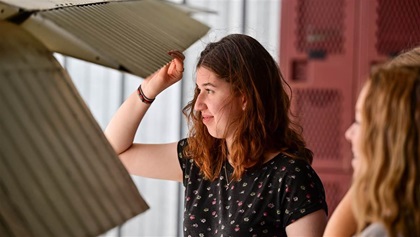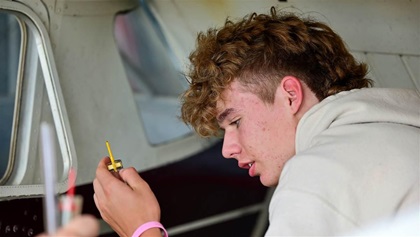A is for airplane
AOPA’s high school curriculum brings STEM smarts, builds a stronger aviation future
You can fly (click on image for slideshow)






Just as he was quizzing them about why pilots sump and check fuel samples, a rumbling sound caused heads to swivel. A cream-colored V-tail Bonanza taxied by, and the students were momentarily entranced. Then it was back to the task at hand.
Similar scenes are playing out at high schools and airports around the country, thanks to the AOPA Foundation High School Aviation STEM Curriculum. Thousands of high school students are getting hands-on experience with airplanes—and they’re leveraging that into successful college, military, and trade school careers.
There are 322 schools in 44 states using the curriculum, with more signing on each year—and 100 percent of the schools that enroll in the program renew—a testament of the program’s popularity among educators and students, as well as a testament to the quality of the curriculum. AOPA conceived the high school curriculum as an initiative to bolster the shrinking pilot population and, in turn, the aviation industry. The courses are designed to capture the imagination and give students from diverse backgrounds the tools to pursue advanced education and careers in aviation fields.
While AOPA was confident that the resources it would provide to high schools through the innovative program would take off like a proverbial rocket, the schools that first signed up to participate—including those with strong support from their local communities—can’t quite believe how successful the program has been, and the impact it is having on their students.
“The people we’re putting out of this program have a leg up on others and proving that what they’ve gained through these experiences is benefiting them greatly,” said Ada City Schools Superintendent Mike Anderson.“It’s been unreal from start to finish,” said Ada High School’s Eckler, whose school was part of the first wave of 29—and the first in Oklahoma—to field test the curriculum as it became available for ninth, then tenth, then eleventh and twelfth grade students. He’s proud to helm Ada High School’s former shop room now turned STEM lab, outfitted with Gleim and Redbird desktop simulators and a full-motion simulator donated by Eastern Oklahoma College. Two radio-controlled Van’s RVs decorated in the Ada High School colors are examples of the students’ introduction to aerodynamics and engineering. They built the models on Saturday mornings, Eckler said.
As lead instructor, Eckler has seen graduating seniors head to professional pilot programs at the University of Oklahoma and Southeastern Oklahoma State University, while another is enrolled in an engineering program at East Central University in Ada, and yet another is a cadet at the U.S. Air Force Academy in Colorado Springs, Colorado. What’s more, students who embark on flight training—which the high school does not provide but is instead funded through scholarships provided by a community foundation—typically solo in less than 10 hours. “They figured out the sim before I did,” Eckler said of his upperclassmen.
“The people we’re putting out of this program have a leg up on others and proving that what they’ve gained through these experiences is benefiting them greatly,” said Ada City Schools Superintendent Mike Anderson, whose vision for the program was to see “kids with their pilot’s licenses and flying before they leave high school. And here it is. We’re doing it.”
Students who choose the aviation path want to be there. In addition to the core subjects, Oklahoma’s Department of Education requires students to take two computer science or two foreign language classes to graduate; anything else in an elective, so students must ensure they meet those requirements. (A state Senate bill has been drafted to credit aviation toward required coursework so that the curriculum could count as something other than an elective; if enacted, the bill would make it easier for the state’s students to graduate high school on time while being enrolled in the high school curriculum.)
Ava Manwell and Isabella King, two of the sophomores whose eyes were drawn to the Bonanza earlier, said they enjoy the aviation program and want to stay with it. They both plan to take flight instruction when they become eligible in their junior year of high school. Manwell said she plans to take the private pilot knowledge test this summer to better prepare her for the flight training. Although she hasn’t decided what she’ll study in college, she said all the options she’s discovered through the aviation program are on the table.
“When we ask [the community] for something, they never say ‘no.’ They just say, ‘How can we help, and when can we get started?’ And it’s been that way from the beginning.” —Ada City Schools Superintendent Mike AndersonOne of Eckler’s juniors described his first flight lesson as “scary” but said he wants to learn to fly so that he can travel—and so that he can earn a good salary and help his family. Eckler later told us that this student, one of eight children, works part-time restaurant jobs to help out. When he applied for a scholarship, his mother couldn’t locate his birth certificate—so he walked five miles to the county health department to obtain a copy. And this student’s experience is not isolated. Forty-five percent of teachers and 54 percent of students in the AOPA High School STEM Curriculum teach or attend schools that are considered mid-high or high poverty—schools with more than 50 percent of students eligible for free or reduced-price lunches.
Reaching 2,500 students
Promotion of the high school curriculum—and aviation in general—starts early with all students, Anderson said. “When we apply for grants, we make sure to let those folks know we touch 2,500 kids a year with this program,” he said. “We’re introducing aviation to our 4-year-olds at the pre-kindergarten center. We teach A is for airplane, and by the time they reach twelfth grade we have them doing capstone projects and soloing airplanes. It’s pretty cool to watch.” The 4-year-olds not only learn that A is for airplane, they also have a special day dedicated to airplanes—and Chris Eckler has been known to overfly the school in a Cessna 172 so that they can go outside and wave. Each school in the district has a STEM lab, Anderson said. “We have the infrastructure in place to bring kids into those labs and have all kinds of activities—not just with aviation, but it’s certainly a big part of what we do.”
He credits the Ada community—including EAA Chapter 1005—for being outstanding supporters of the program. “When we ask for something, they never say ‘no.’ They just say, ‘How can we help, and when can we get started?’ And it’s been that way from the beginning.” The program’s first flight simulator was a gift from a private individual. “I said we don’t know how to thank you,” Anderson said. “And he said, ‘You don’t have to thank me, you educated my children.’”
New to aviation, not to teaching
Eckler wasn’t a pilot when he started teaching the aviation high school curriculum. He recalled that he felt a little self-conscious when he attended his first AOPA Foundation professional development teacher workshop, where he got an introduction to the curriculum and how to teach it. The other teachers were mostly pilots—some of them high-time, retired airline pilots—but to his surprise, they turned to him with questions about teaching, and he realized he had just as much to bring to the table as they did.
Thanks to the AOPA Foundation You Can Fly Teacher Flight Training program, made possible through the support of the Ray Foundation, Eckler earned a scholarship that got him through his private pilot certificate. He’s now working on the instrument rating, and he’d love to become a flight instructor, thus helping to close something of a gap in Ada’s flight training environment. The CFI at the local flight school has to divide his time between Ada and another airport, he said. As a teacher, he’s accustomed to wearing many hats—but the cap of a CFI is one he covets. [email protected]

 Between football, soccer, and driver’s education—which many schools have shed—public and private high schools have enough liability issues to contend with. Few can afford to provide flight instruction, and most wouldn’t want to.
Between football, soccer, and driver’s education—which many schools have shed—public and private high schools have enough liability issues to contend with. Few can afford to provide flight instruction, and most wouldn’t want to. 




